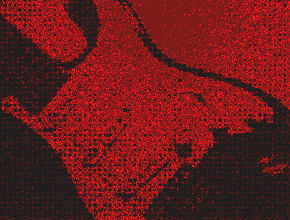If you run any kind of internet website related to metal, you occasionally get cool emails from folks around the world. Recently I heard from a guy named Brian Straight, who in the early 1990s formed a death metal band called “Witch-Hunt” based out of Richmond, VA. A small label called Lost Apparitions Records has just published a retrospective of their underground recordings. The same week as I heard from Brian, I had just moved to Richmond, VA to start a job teaching music theory at the University of Richmond. Too good of a coincidence to pass up!
Witch-Hunt’s songs have a unique brand of melancholic aggression. The band’s guitar and vocal tone could be compared to demos and early albums by Nihilist/Entombed or Mayhem, but they have a somber restrained utterly beyond either of these. This gives the songs a sort of timeless feel that is reinforced by the lyrics and some of the synthesizer intros. I don’t know how this eternal quality was received when Witch-Hunt’s recordings were first made 20 or more years ago—but listening to this release in the present is an awesome experience. It’s a bit like picking up some gruesome obsolete weapon in a forgotten corner, blowing off the dust, and finding out that it’s still finger-splitting sharp.
A reviewer for Erebus magazine describes this atmosphere beautifully in an essay about Witch-Hunt’s only full-length album:
“To be sure, there is a lot of aggression on this release, as befits their chosen genre and style, but it sounds almost like it is being related to your ears second-hand: like a tale you are being told of violent times, not the actual creation of violence as such. This is also a characteristic of this album that I enjoyed: these songs have a seasoned, worked-out, ‘smooth’ feel to them, as if they had been rehearsed and worked on so many times that their subsequent performance for this recording was completely instinctive to the band.”
https://erebuszine.blogspot.com/2010/05/witch-hunt-souls-enshrouded-fire.html
It doesn’t sound easy or boring, but the terrorizing chaos that often breeds in 90s death metal is tempered and controlled here, horror and aggression subdued into these monolithic, arcing chains of riffs that feel so inevitable, as if there’s no other riff in the world that could have followed in that specific order.
I felt this especially strongly with the first track of the retrospective, “Fragments.” I began making a chart of this song, and heard a riff late in the song that sounded familiar but I couldn’t quite place it. Turns out I had never heard it before at all. But the riffs in this song are like twisted, forgotten echoes of one another, making each new riff have this sort of hazily-remembered familiar feeling, even though the riffs are each as original as anything else in this deeply stylized genre.
I’ll show you what I mean by “echoes of one another.” Each of the riffs in “Fragments” is fundamentally based on the same melodic move, from G to Eb. These aren’t simple “variations” that slightly modifies the rhythmic surface or texture. They are completely different in rhythmic quality and proportion; Riffs D and E have an atonal freneticism that reminds me of Slayer, but Riff B would be more at home on a doom metal track. Riff B makes this G-Eb move like a lurching step, while in Riff E the anchoring Eb descent is a fateful, inevitable lowering of a gavel. But this move from G to Eb is somehow essential to each riff.

Each riff seems to carry on the thread of a story, despite dramatic changes in rhythm and speed. This gives the song an epic but dissociative quality, like a tale of horrific acts that has been spun out and retold so much that the visceral pain of the original event fades into a ritualized fable.
Here’s another revealing small detail that shows Witch-Hunt’s thoughtful songwriting approach. Just before 3:00 into the song, the singer laments,
What Became Of My Will? Clouded By Thought,
Drowned By Tears That Reflect A Lost Part
Of My World.
The song changes keys at “reflect a lost part of my world,” transitioning into a bridge that is a kind of alternate reality tonally detached from the main sections of the song, a beautiful if chilling evocation of this anguished loss described in the lyrics. What follows this is the most rhythmically intense section, featuring some brazen metric shifts that I would bet make for a great chaotic mosh pit.
Other songs on this album are just as somber, just as carefully constructed, just as powerful. This art of careful riff-to-riff sequencing is rare in metal songwriting, and under-appreciated in metal criticism. But that kind of craftsmanship and musicianship is one major reason why the songs on this retrospective still hold up after two or more decades in the archives.

Amazing analysis… I never gave it this much thought, and I wrote the song! Thank you for the outstanding and insightful review.